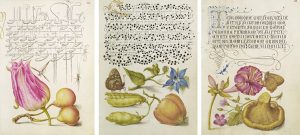The Nuremberg Residence and Garden of Magdalene Pairin in Genealogy of the Derrer Family


Bathsheba Bathing (detail), foliage from the Hours of Louis XII, 1498–99, Jean Bourdichon. Tempera colors and gold on parchment, 9 9/xvi x 6 11/xvi in. The J. Paul Getty Museum, Ms. 79, recto
A tour through sumptuous Renaissance gardens depicted in illuminated manuscripts.

Past Dr. Bryan C. Keene / 08.09.2013
Adjunct Professor of Art History
Pepperdine Academy
Gardens are rich with associations: the Garden of Eden is an earthly paradise; botanical gardens are places to study and appreciate the world of plant life; our home herb and flower gardens are sites of pleasure, sustenance, leisure, and sometimes chore.
The gardens we run across in works of art from the Renaissance in Europe, from about 1400 to 1600, similarly reveal a range of meanings and functions—several of which resonate with our own gimmicky ideas. Here is a visual introduction to Renaissance gardens and their symbolism, with images drawn from illuminated manuscripts in the Getty Museum's collection.
Kitchen Gardens

Harvest Scene (entire illumination, left, and detail, right), completed before 1340, attributed to Illustratore (Andrea da Bologna?). Cutting fromNew Digest. Tempera colors, gilded leaf, and ink on parchment, 5 xi/16 x three in. The J. Paul Getty Museum, Ms. 13, verso
A kitchen garden—hortus in Latin ororto in Italian—was oft part of a landed estate or attached to a unproblematic dwelling. These sites produced plants for sustenance and profit, oftentimes providing taxable income. In the illumination to a higher place, individuals harvest the plantings from a vineyard and orchard.
Urban Gardens

The Annunciation (detail) in the Spinola Hours, virtually 1510–20, Master of James Four of Scotland. Tempera colors, gilt, and ink on parchment, 9 one/8 x 6 9/16 in. The J. Paul Getty Museum, Ms.Ludwig IX xviii, fol. 92v
The urban garden, orhortus urbanus to infringe a phrase coined by the 15th-century theorist Leon Battista Alberti, combined the dignity of a city house with the delights of a country villa and provided a place gratuitous from the restrictions of urban society. These gardens were sites of wistful withdrawal. In the illumination here, angels tend a garden attached to the Virgin Mary'due south home, pictured hither with early on-16th-century architecture.
Herb Gardens

March: Gardening; Zodiacal Sign of Aries (particular) in the Spinola Hours, Workshop of the Primary of James Four of Scotland. Tempera colors, gilded, and ink on parchment, 9 1/8 ten 6 9/16 in. The J. Paul Getty Museum, Ms. Ludwig IX 18, fol. 2v
An herb orsimples garden was ofttimes located about a private residence, a pharmacy, or university, and was used for the product of medicinal remedies. Here a young couple watch every bit gardeners till the soil in the garden in early spring.
Cloister Gardens

Saint Jerome Reading (detail) in the Spinola Hours, almost 1510–20, Workshop of the Master of the Get-go Prayer Book of Maximilian. Tempera colors, gold, and ink on parchment, 9 1/viii x six 9/xvi in. The J. Paul Getty Museum, Ms. Ludwig IX 18, fol. 223v
The gardens found in monasteries or cloisters were oftentimes referred to as paradise on earth, a reference to the Garden of Eden, portrayed hither—in another beautiful example from the Spinola Hours—with lush colors and arable dark-green.
Botanical Gardens

Insect, Tulip, Caterpillar, Spider, Pear(left),Speckled Forest, Talewort, Garden Pea, and Lantern Plant(center), andFour-o'Clock, Chocolate-brown Hairstreak, Herb Robert, and Chanterelle(right) inModel Volume of Calligraphy, Georg Bocskay, scribe, 1561–62; Joris Hoefnagel, illuminator, 1591–96. Watercolors, gold paint, silver pigment, and ink on parchment, 6 nine/sixteen x 4 vii/eight in. The J. Paul Getty Museum, Ms. 20, fols. 25, sixteen, 32
The botanical garden got its starting time in Renaissance Italian republic (in Padua, Pisa, and Florence), and spread throughout Europe, including to sites within the Holy Roman Empire nether Emperor Rudolf II. Many of the specimens found in his botanical garden tin can be seen today in the Model Book for Calligraphy, illuminated with spellbinding precision past Joris Hoefnagel.
Court Gardens

Bathsheba Bathing, leaf from the Hours of Louis XII, 1498–99, Jean Bourdichon. Tempera colors and golden on parchment, 9 9/16 ten six xi/16 in. The J. Paul Getty Museum, Ms. 79, recto
Gardens at Renaissance courts were largegiardini connected to Italian villas or luxuriousjardins establish in French châteaux. Gardens such as the Boboli gardens in Florence, or the luxurious greenish spaces at the Château de Fontainebleau in France, represent the top of villa and château gardening in the 16the century.
These spaces provided pleasure, not necessarily profit, as hinted in this illumination of Bathsheba bathing.
Secret Gardens

Froissart Kneeling before Gaston Phébus, Count of Foix (entire page, left, and particular, right) inChronicles(Volume Iii), well-nigh 1480–83, Master of the Soane Josephus. Tempera colors, aureate leaf, gold paint, and ink on parchment, 18 7/8 ten 13 3/4 in. The J. Paul Getty Museum, Ms. Ludwig Xiii 7, fol. nine
One specific blazon of courtly garden is the so-called secret garden (giardino secreto). The proper noun did not imply a hidden infinite, but rather one that was distinguished, set apart, or reserved for the privacy of an manor possessor and his closest associates, such as the garden seen through the window hither.
Virtue and Vice

The Lover Views the Garden (item) inRomance of the Rose, near 1405, unknown illuminator. Tempera colors and gilded foliage on parchment, 14 seven/xvi 10 ten 1/4 in. The J. Paul Getty Museum, Ms. Ludwig XV 7, fol. 5v
In improver to serving different functions, Renaissance gardens likewise carried a range of associations, both literary and biblical. The Garden of Beloved, defended to the goddess Venus, was a pleasance garden of virtue and vice—suggested here past the position of the homo's hand at center.
Paradise

The Temptation of Adam and Eve (particular) inConcerning the Fates of Illustrious Men and Women, nearly 1415, Boucicaut Master. Tempera colors, gold leaf and gold paint on parchment, 16 9/xvi x 11 5/8 in. The J. Paul Getty Museum, Ms. 63, fol. iii
The biblical Garden of Eden was about often referred to as "paradise," a word that evoked the notion of an untouched and fundamental mural, a truelocus amoenus, or pleasurable space, every bit in this lush landscape of greenery and gold.
Crucifixion and Resurrection

Noli me tangere in Prayer Volume of Charles the Bold, 1469, Lieven van Lathem. Tempera colors, gilt leaf, golden paint, argent paint, and ink on parchment, 2 ane/two 10 i thirteen/xvi in. The J. Paul Getty Museum, Ms. 37, fol. 46v
Christ is associated with Jerusalem gardens, where, according to the Bible, he prayed and was betrayed on the eve of the crucifixion and where he was cached and resurrected. Upon Christ's resurrection Mary Magdalene initially mistook him for a gardener, and thus artists in the Renaissance, every bit in this leaf past Lieven van Lathem, often depicted him holding a shovel.
By Preserved
Gardens are cyclical, impermanent, and ephemeral–"ever changing, never twice the aforementioned," to borrow Robert Irwin's words about the Getty Heart's Fundamental Garden. But in some instances, inheritors of Renaissance gardens attempted to preserve their graphic symbol, as is the case at Boboli, Fontainebleau, and other major sites today.
In a genealogical manuscript in our drove, nosotros find in Nuremburg a house and garden, built and cultivated in the year 1502 and appearing virtually unchanged until the mid-17th century, when the manuscript was fabricated. The artist provided two aerial views of the site, one in the main paradigm and the other fatigued at left. Thanks to Google Maps, we tin can really locate this garden—and are surprised and delighted to see that its design is largely the same as it was when the manuscript was illuminated, over 300 years ago.

The Nuremberg Residence and Garden of Magdalene Pairin in Genealogy of the Derrer Family, nearly 1626–1711, Georg Strauch. Tempera colors with gold and silver highlights on parchment, fourteen 13/16 x 10 ane/iv in. The J. Paul Getty Museum, Ms. Ludwig XIII 12, fol. 130bis. At right, aerial view of the garden today via Google Maps, with the garden depicted in the manuscript outlined in green.
Gardens come up in myriad forms and represent a plethora of ideas about the natural globe and the cultivated landscape, ideas that change with fourth dimension and geography. What associations practice yous make with gardens?
Originally published past The Iris under a Creative Commons Attribution 4.0 International license.
Comments
Source: https://brewminate.com/a-field-guide-to-renaissance-gardens/
ارسال یک نظر for "The Nuremberg Residence and Garden of Magdalene Pairin in Genealogy of the Derrer Family"